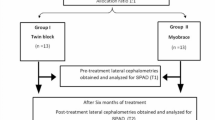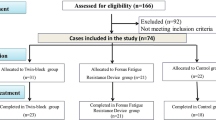Abstract
Objectives
Skeletal class II malocclusion is one of the most common malocclusions. Among the functional appliances for skeletal class II malocclusion, the Twin-Block appliance with a maxillary expander is effective in repositioning the mandible forward. In this study, we focused our efforts on investigating the effects of Twin-Block appliances with maxillary expanders on the upper airway in growing children with skeletal class II malocclusion by tracing and measuring lateral cephalograms after evaluating the consistency of three-dimensional CBCT data and two-dimensional lateral cephalogram data.
Materials and methods
A total of 102 patients ranging from 9 to 15 years old (11.37 ± 2.80, male/female ratio = 1:1) with skeletal class II malocclusion were selected to evaluate the consistency of CBCT data and lateral cephalogram data. The strongly and moderately correlated segments were then selected to study the effects of Twin-Block with a maxillary expander on the upper airway in 66 growing children with skeletal class II malocclusion (11.31 ± 1.23 years old, male/female ratio = 1:1) by lateral cephalograms.
Results
The results showed a strong significant correlation in the nasopharynx (r = 0.708) and moderate significant correlations in the overall upper airway (r = 0.641), palatopharynx (r = 0.553), and glossopharynx (r = 0.575) but a weak correlation in the hypopharynx (r = 0.323). The corresponding determination coefficient (R2) was also determined by scatter plot analysis. Moreover, compared with the pretreatment data (T1), the total area of the upper airway and the areas of the nasopharynx, palatopharynx, and glossopharynx after functional treatment (T2) increased statistically and significantly.
Conclusions
Lateral cephalograms can reflect the volume of the nasopharynx and oropharynx in skeletal class II children to a certain extent, while Twin-Block appliances with maxillary expanders can widen the volume of the nasopharynx and oropharynx significantly.
Clinical relevance
The lateral cephalogram is reliable for analyzing the nasopharynx, palatopharynx, and glossopharynx in orthodontic clinical practice. Twin-Block appliances with maxillary expanders have a positive effect on skeletal class II patients with airway stenosis.



Similar content being viewed by others
Data Availability
All relevant data are within the manuscript and its Additional files.
References
Mohamed RN, Basha S, Al-Thomali Y (2020) Changes in upper airway dimensions following orthodontic treatment of skeletal class II malocclusion with Twin Block appliance: a systematic review. Turk J Orthod 33:59–64. https://doi.org/10.5152/TurkJOrthod.2020.19028
Knösel M, Espinoza-Espinoza GE, Sandoval-Vidal P, Zaror C (2020) Angle class II correction: stepwise mandibular advancement or bite jumping? : a systematic review and meta-analysis of skeletal, dental and condylar effects. J Orofac Orthop 81:286–300. https://doi.org/10.1007/s00056-020-00226-6
Henry R (1957) A classification of class II division I malocclusion. Angle Orthod 27:83–92
Entrenas I, González-Chamorro E, Álvarez-Abad C et al (2019) Evaluation of changes in the upper airway after Twin Block treatment in patients with class II malocclusion. Clin Exp Dent Res 5:259–268. https://doi.org/10.1002/cre2.180
Ghaffar F, Jan A, Akhtar O et al (2021) Comparative analysis of dentoskeletal changes of the Twin Block appliance and the AdvanSync2 appliance in treatment of skeletal class-II malocclusion in Pakistani population: a randomized clinical trial. Eur J Dent 16:680–687. https://doi.org/10.1055/s-0041-1739543
Daraze A (2018) Cephalometric evaluation of the hyoid bone position in Lebanese healthy young adults. J Contemp Dent Pract 19:490–501
Ning R, Guo J, Martin D (2022) Effect of premolar extraction on upper airway volume and hyoid position in hyperdivergent adults with different mandibular length. Am J Orthod Dentofacial Orthop 161:e390–e399
Chen Y, Hong L, Wang CL et al (2012) Effect of large incisor retraction on upper airway morphology in adult bimaxillary protrusion patients. Angle Orthod 82(6):964–970. https://doi.org/10.2319/110211-675.1
Vizzotto MB, Liedke GS, Delamare EL et al (2012) A comparative study of LCs and cone-beam computed tomographic images in upper airway assessment. Eur J Orthod 34:390–393. https://doi.org/10.1093/ejo/cjr012
Jiang YY, Suna L, Wang H et al (2020) Three-dimensional cone beam computed tomography analysis of temporomandibular joint response to the Twin-block functional appliance. Korean J Orthod 50:86–97
Thakur VK, Londhe SM, Kumar P et al (2021) Evaluation and quantification of airway changes in class II division 1 patients undergoing myofunctional therapy using twin block appliance. Med J Armed Forces India 77:28–31
Verma G, Tandon P, Nagar A et al (2012) Cephalometric evaluation of hyoid bone position and pharyngeal spaces following treatment with Twin block appliance. J Orthod Sci 1:77–82. https://doi.org/10.4103/2278-0203.103863
Magda BBG, Isabelle TC, Richard H et al (2023) Risk of hematological malignancies from CT radiation exposure in children, adolescents and young adults. Nat Med 29:3111–3119. https://doi.org/10.1038/s41591-023-02620-0
El H, Palomo JM (2013) An airway study of different maxillary and mandibular sagittal positions. Eur J Orthod 35:262–270. https://doi.org/10.1093/ejo/cjr114
Brito FC, Brunetto DP, Nojima MCG (2019) Three-dimensional study of the upper airway in different skeletal class II malocclusion patterns. Angle Orthod 89:93–101. https://doi.org/10.2319/112117-806.1
Eliana DC, Danieli MB, Hugo GA, Varner LL, Gina DR (2022) Imaging of the upper airway: which method is best for orthodontic assessment? Gen Dent 70:51–55
Zimmerman JN, Vora SR, Pliska BT (2019) Reliability of upper airway assessment using CBCT. Eur J Orthod 41:101–108. https://doi.org/10.1093/ejo/cjy058
dos Santos Azevedo WR, Feitoza CC, Vargas Junior CS, ColetaPizzol KED (2018) Changes in head posture, hyoid bone position and airway dimensions after orthognatic surgery. Braz J Oral Sci 17:e18030. https://doi.org/10.20396/bjos.v17i0.8652645
Lenza MG, de O. Lenza MM, Dalstra M et al (2010) An analysis of different approaches to the assessment of upper airway morphology: a CBCT study[J]. Orthod Craniofac Res 13:96–105
Eslami E, Katz ES, Baghdady M et al (2017) Are three-dimensional airway evaluations obtained through computed and cone-beam computed tomography scans predictable from LCs? Angle Orthod 87:159–167
Savoldi F, Xinyue G, McGrath CP et al (2020) Reliability of lateral cephalometric radiographs in the assessment of the upper airway in children: a retrospective study. Angle Orthod 90:47–55. https://doi.org/10.2319/022119-131.1
Li J, Ge X, Guan H, Zhang S et al (2021) Three-dimensional changes of the upper airway in patients with class II malocclusiontreated with functional appliances: a systematic review and meta-analysis. Eur J Orthod 43:415–423
Martins LS, Liedke GS, Heraldo LDS et al (2018) Airway volume analysis: is there a correlation between two and three-dimensions? Eur J Orthod 40:262–267
Eslami E, Katz ES, Baghdady M et al (2017) Are three-dimensional airway evaluations obtained through computed and cone-beam computed tomography scans predictable from lateral cephalograms? A systematic review of evidence. Angle Orthod 87(1):159–167. https://doi.org/10.2319/032516-243.1
Battagel JM, Johal A, L’Estrange PR et al (1999) Changes in airway and hyoid position in response to mandibular protrusion in subjects with obstructive sleep apnoea (OSA). Eur J Orthod 21:363–376. https://doi.org/10.1093/ejo/21.4.363
Vinoth SK, Thomas AV, Nethravathy R (2013) Cephalomteric changes in airway dimensions with twin block therapy in growing class II patients. J Pharm Bioallied Sci 5:25–29. https://doi.org/10.4103/0975-7406.113288
Chen N, Xiong B, Zhang T et al (2021) Changes of the upper airway in children with class II mandibular retrusion and snoring during night before and after functional treatment by sagittal-guidance Twin-block appliance. Shanghai Kou Qiang Yi Xue 30:273–377
Ali B, Shaikh A, Fida M (2015) Effect of Clark’s twin-block appliance (CTB) and non-extraction fixed mechano-therapy on the pharyngeal dimensions of growing children. Dent Press J Orthod 20:82–88. https://doi.org/10.1590/2177-6709.20.6.082-088.oar
Tepedino M, Montaruli G, Scapato F et al (2021) Long-term effect on adenoid dimensions and craniocervical angulation after maxillary expansion with fixed or functional appliances. J Clin Exp Dent 13:e594–e600. https://doi.org/10.4317/jced.58171
Fujioka M, Young LW, Girdany BR (1979) Radiographic evaluation of adenoidal size in children: adenoidal-nasopharyngeal ratio. AJR Am J Roentgenol 133:401–404. https://doi.org/10.2214/ajr.133.3.401
Vinoth SK, Thomas AV, Nethravathy R (2019) Effects of rapid maxillary expansion on upper airway volume: a three-dimensional cone-beam computed tomography study. Angle Orthod 89:917–923. https://doi.org/10.2319/101218-738.1
Jena AK, Singh SP, Utreja AK (2013) Effectiveness of twin-block and Mandibular Protraction Appliance-IV in the improvement of pharyngeal airway passage dimensions in class II malocclusion subjects with a retrognathic mandible. Angle Orthod 83:728–734. https://doi.org/10.2319/083112-702.1
Ghodke S, Ak Utreja SP, Singh AKJ (2014) Effects of twin-block appliance on the anatomy of pharyngeal airway passage (PAP) in class II malocclusion subjects. Prog Orthod 15:68. https://doi.org/10.1186/s40510-014-0068-3
Bronoosh P, Khojastepour L (2015) Analysis of pharyngeal airway using lateral cephalogram vs CBCT images: a cross-sectional retrospective study. Open Dent J 2015:263–266
Acknowledgements
We would like to thank Dr. Xiaoxi Wei and Dr. Zhi Mao at Jilin University for their excellent technical assistance and scientific input.
Funding
This study was supported by the National Natural Science Foundation of China [82100956] and the Natural Science Foundation of Jilin Province, China [YDZJ202301ZYTS432].
Author information
Authors and Affiliations
Contributions
Feng Mao executed the study, collected the data, and wrote the manuscript; Chenmeng Lu, Nan Liu, and Zhiqing Liu collected and analyzed the data; Yi Zhang edited the manuscript; Huichuan Qi and Min Hu conceived and designed the study, interpreted the data, and approved the manuscript.
Corresponding authors
Ethics declarations
Ethics approval and consent to participate
All participants were written informed consents. The experimental designs and protocols were approved by the Institutional Review Board of Jilin University (JLUIRB-2022–59).
Competing interests
The authors declare no competing interests.
Additional information
Publisher's Note
Springer Nature remains neutral with regard to jurisdictional claims in published maps and institutional affiliations.
Supplementary Information
Below is the link to the electronic supplementary material.
Rights and permissions
Springer Nature or its licensor (e.g. a society or other partner) holds exclusive rights to this article under a publishing agreement with the author(s) or other rightsholder(s); author self-archiving of the accepted manuscript version of this article is solely governed by the terms of such publishing agreement and applicable law.
About this article
Cite this article
Mao, F., Lu, C., Liu, N. et al. Effects of Twin-Block with an expanding device on the upper airway in growing children with skeletal class II malocclusion—a retrospective study based on the consistency of three-dimensional and two-dimensional data. Clin Oral Invest 28, 4 (2024). https://doi.org/10.1007/s00784-023-05388-2
Received:
Accepted:
Published:
DOI: https://doi.org/10.1007/s00784-023-05388-2




